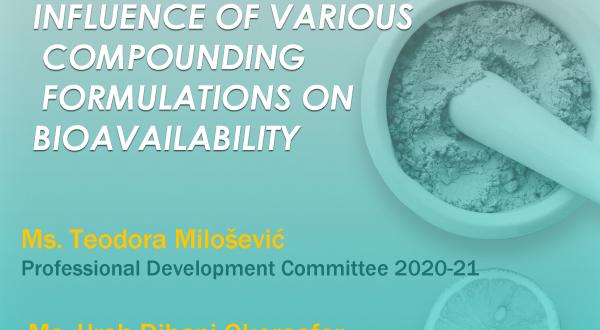
Pharmacists as Immunisers in Canada
Pharmacists as Immunisers in Canada
By Sofiya Terekhovska and Danielle Shymanski
With the anti-vaccination movement on the rise globally, healthcare systems are faced with an increase in vaccine hesitancy sentiments. Vaccine hesitancy — the voluntary refusal or delay in vaccination despite a vaccine’s availability — not only increases the risk of outbreaks in unvaccinated people, but also leads to a deficit in herd immunity (1). While many healthcare professionals play a vital role in vaccination, pharmacists are ideally positioned to distribute, administer and educate about vaccines due to their extensive knowledge and accessibility.
Recently, the International Pharmaceutical Students’ Federation (IPSF) released a Declaration on Vaccine Hesitancy, where the Federation listed several calls to action on behalf of pharmacy students and recent graduates, addressing efforts required from pharmaceutical companies, national governments, academic institutions and professional associations.
The Canadian Association of Pharmacy Students and Interns (CAPSI) recognises the growing concern of global vaccine hesitancy and stands in support of the declaration. The purpose of this article is to demonstrate the benefits of pharmacist involvement in vaccination in Canada, namely administering vaccinations, improving vaccine-related health literacy and increasing access to vaccination. This pharmacist involvement has contributed to the increase in vaccination rates in Canada. CAPSI hopes that this article can serve as the groundwork for other IPSF Member Organisations and encourage advocacy for greater pharmacist involvement in vaccination in other countries.
In Canada, patients have expressed support for pharmacist-administered vaccination. In fact, a Canadian study suggests that 80% of influenza vaccine recipients prefer getting their vaccine at pharmacies (2, 3). While numerous factors influence an individual’s decision to be vaccinated, access is often a significant obstacle (4-7). In provinces where pharmacists are allowed to administer influenza and other immunisations, there is a higher uptake of immunisations by the general public (8). Authorising community pharmacists to administer vaccines could help overcome issues with accessibility given the ubiquitous distribution of pharmacies, extended working hours and walk-in policies (3, 9, 10). Furthermore, the accessibility of pharmacists in medically underserved areas has been shown to improve immunisation rates. Another potential benefit is the avoidance of encountering infectious individuals in clinic waiting rooms when seeking preventative health measures (11). In addition to improving overall vaccination rates, pharmacists as administrators of vaccines could help to improve vaccination rates among hard-to-reach populations, such as young adults with no primary care physician (12).
Improving immunisation rates is known to reduce the burden of vaccine-preventable diseases in adults. Additionally, vaccinations lessen healthcare associated costs of vaccine-preventable diseases via reduced incidence rates and disease-related complications (13-15). From an economic standpoint, a recent study done in the Canadian province of Ontario shows that the implementation of the Pharmacy Based Immunization Services resulted in savings up to $2.3 million CAD. These savings were a result of preventing indirect healthcare costs and lost productivity since flexible pharmacy hours accommodate work days and immunisations reduce sick leave (16).
In addition to administering vaccinations, pharmacists are ideally positioned to educate their patients regarding vaccinations, and thus to counteract vaccine hesitancy among the general public. Pharmacists receive education regarding health, medications and immunisations in an accredited university pharmacy program, typically ranging four to five years following prerequisite courses. Numerous studies have demonstrated that pharmacist consultations result in higher immunisation rates, including pneumococcal and influenza vaccinations (17-18). Evidently, pharmacist involvement as the educator has the potential not only to increase immunisation rates, but also to change the public’s view of vaccines and help dissipate vaccine-related myths.
While not all countries have an existing legislative framework that allows pharmacists to contribute to immunisations, there are numerous benefits of pharmacy-based vaccination services. Pharmacists are ideally positioned to be involved in immunisation of the public due to their extensive knowledge and accessibility. Allowing pharmacists to be involved in immunisation — whether as administrators or educators — has the potential to increase immunisation rates, save healthcare costs, as well as counteract the anti-vaccination movement. After all, the aforementioned evidence is strongly supportive of putting immunisation services into the hands of highly accessible and trusted healthcare providers.
References:
- Pharmacist vaccine hesitancy [Internet]. OPEN. [cited 2020Mar29]. Available from: https://www.open-pharmacy-research.ca/research-projects/pharmacist-vaccine-hesitancy/
- Wan K. Ontario Pharmacists Association [Internet]. Most Ontarians would go to their pharmacist for immunizations, survey shows. [cited 2020Mar11]. Available from: https://www.opatoday.com/professional/news/most-ontarians-would-go-to-their-pharmacist-for-immunizations-survey-shows
- Bowles S, Strang R, Wissmann E. A Pilot Program of Community Pharmacy—Based Influenza Immunization Clinics. Canadian Pharmacists Journal / Revue des Pharmaciens du Canada. 2005;138(6):38–.
- Santoli JM, Sziiagyi PG, Rodewald LE. Barriers to Immunization and Missed Opportunities. Pediatric Annals. 1998Jan;27(6):366–74.
- Johnson DR, Nichol KL, Lipczynski K. Barriers to Adult Immunization. The American Journal of Medicine. 2008;121(7).
- Lester RT, Mcgeer A, Tomlinson G, Detsky AS. Use of, Effectiveness of, and Attitudes Regarding Influenza Vaccine Among House Staff. Infection Control & Hospital Epidemiology. 2003;24(11):839–44.
- Kroneman M, Essen GAV, Paget WJ. Influenza vaccination coverage and reasons to refrain among high-risk persons in four European countries. Vaccine. 2006;24(5):622–8.
- Buchan SA, Rosella LC, Finkelstein M, Juurlink D, Isenor J, Marra F, et al. Impact of pharmacist administration of influenza vaccines on uptake in Canada. Canadian Medical Association Journal. 2016Aug;189(4).
- Grabenstein J, Guess H, Hartzema A, Koch G, Konrad T. Attitudinal factors among adult prescription recipients associated with choice of where to be vaccinated1. Journal of Clinical Epidemiology. 2002;55(3):279–84.
- Marra F, Kaczorowski J, Gastonguay L, Marra CA, Lynd LD, Kendall P. Pharmacy-based Immunization in Rural Communities Strategy (PhICS). Canadian Pharmacists Journal / Revue des Pharmaciens du Canada. 2014;147(1):33–44.
- Papastergiou J, Folkins C, Li W, Zervas J. Community pharmacist–administered influenza immunization improves patient access to vaccination. Canadian Pharmacists Journal / Revue des Pharmaciens du Canada. 2014;147(6):359–65.
- Vlahov D, Coady MH, Ompad DC, Galea S. Strategies for Improving Influenza Immunization Rates among Hard-to-Reach Populations. Journal of Urban Health. 2007Dec;84(4):615–31.
- Bonmarin I, Belchior E, Lévy-Bruhl D. Impact of influenza vaccination on mortality in the French elderly population during the 2000–2009 period. Vaccine. 2015;33(9):1099–101.
- Ryan J, Zoellner Y, Gradl B, Palache B, Medema J. Establishing the health and economic impact of influenza vaccination within the European Union 25 countries. Vaccine. 2006;24(47-48):6812–22.
- Lai C-C, Lin S-H, Liao C-H, Sheng W-H, Hsueh P-R. Decline in the incidence of invasive pneumococcal disease at a medical center in Taiwan, 2000–2012. BMC Infectious Diseases. 2014Nov;14(1).
- O'reilly D, Blackhouse G, Burns S, Bowen J, Burke N, Mehltretter J, et al. Economic analysis of pharmacist-administered influenza vaccines in Ontario, Canada. ClinicoEconomics and Outcomes Research. 2018;Volume 10:655–63.
- Queeno BV. Evaluation of Inpatient Influenza and Pneumococcal Vaccination Acceptance Rates With Pharmacist Education. Journal of Pharmacy Practice. 2016Sep;30(2):202–8.
- Chou TI-F, Lash DB, Malcolm B, Yousify L, Quach JY, Dong S, et al. Effects of a student pharmacist consultation on patient knowledge and attitudes about vaccines. Journal of the American Pharmacists Association. 2014;54(2):130–7.



